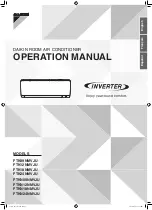
1 sec, the fan relay is energized. When the thermostat is satisfied,
an off delay is initiated. When the fixed delay of 90
±
20 sec is
completed, the fan relay is de-energized and fan motor stops. If the
wall thermostat closes during this delay, the TDR is reset and the
fan relay remains energized. The TDR is a 24-v device that
operates within a range of 15v to 30v and draws about .5 amps.
If the blower runs continuously instead of cycling off when the fan
switch is set on AUTO, the TDR is probably defective and must be
replaced.
Step 8—Pressure Switches
The low-pressure switch used on the 38TN unit is the switch
normally used in heat pump applications. The standard air condi-
tioner low-pressure switch is NOT used.
Pressure switches are protective devices wired into control circuit
(low voltage). They shut off compressor if abnormally high or low
pressures are present in the refrigeration circuit. Depending on unit
model, you may find a low- and/or high-pressure switch in system.
LOW-PRESSURE SWITCH — The low-pressure switch is lo-
cated on suction line and protects against low suction pressures
caused by such events as loss of charge, low airflow across indoor
coil, dirty filters, etc. It opens on a pressure drop at about 7 psi. If
system pressure is above this, switch should be closed. To check
switch, turn off all power to unit, disconnect leads on switch, and
apply ohmmeter leads across switch. You should have continuity
on a good switch. Because these switches are attached to refrig-
eration system under pressure, it is not advisable to remove this
device for troubleshooting unless you are reasonably certain that a
problem exists. If switch must be removed, remove and recover all
system charge so that pressure gages read 0 psi.
Wear safety glasses and gloves when working with refriger-
ants.
Apply heat with torch to solder joint and remove switch. Wear
safety glasses when using torch. Have quenching cloth available.
Oil vapor in line may ignite when switch is removed.
Braze in 1/4-in. flare fitting and screw on replacement pressure
switch.
HIGH-PRESSURE SWITCH — The high-pressure switch is lo-
cated on liquid line, and protects against high discharge pressures
caused by such events as overcharge, condenser fan motor failure,
system restriction, etc. It opens on pressure rise at about 425 psi.
If system pressures go above this setting during abnormal condi-
tions, the switch opens. Do not attempt to simulate these system
abnormalities as high pressures pose a serious safety hazard.
High-pressure switch is also checked with an ohmmeter similar to
checking low-pressure switch. If system pressure is below 425 psi,
the switch shows continuity. It is replaced in the same manner as
low-pressure switch. Observe all safety precautions.
Step 9—Fan Motor
Fan motor rotates the fan blade that either draws or blows air
through outdoor coil to perform heat exchange. Motors are totally
enclosed to increase reliability. This also eliminates need for rain
shield. For the correct position of the fan blade assembly, see Fig.
12. The A dimension indicated in Fig. 12 equals 6-1/8 in.
Turn off all power to unit before servicing or replacing fan
motor. Be sure unit main power switch is turned off. Failure
to do so may result in electric shock, death, or injury from
rotating fan blade.
The bearings are permanently lubricated, therefore, no oil ports are
provided.
For suspected electrical failures, check for loose or faulty electrical
connections, or defective fan motor capacitor. Fan motor is
equipped with thermal overload device in motor windings which
may open under adverse operating conditions. Allow time for
motor to cool so device can reset. Further checking of motor can
be done with an ohmmeter. Set scale on R X 1 position, and check
for continuity between 3 leads. Replace motors that show an open
circuit in any of the windings. Place 1 lead of ohmmeter on each
motor lead. At same time, place other ohmmeter lead on motor
case (ground). Replace any motor that shows resistance to ground,
arcing, burning, or overheating.
Step 10—Compressor Plug
The compressor electrical plug provides a quick-tight connection
to the compressor terminals. The plug completely covers the
compressor terminals and the mating female terminals are com-
pletely encapsulated in the plug. Therefore, the terminals are
isolated from any moisture so corrosion and resultant pitted or
discolored terminals are reduced. The plug is oriented to the relief
slot in the terminal box so the cover cannot be secured if wires are
not positioned in slot, assuring correct electrical connection at the
compressor. The plug can be removed by simultaneously pulling
while "rocking" the plug. However, these plugs are specialized and
vary in terminal orientation. Therefore, plugs can be used on only
the specific compressor. Fig. 13 shows compressor plug configu-
ration for the Millennium scroll compressor. The configuration
around the fusite terminals is the outline of the terminal covers.
The slot through which the wires of the plug are routed is oriented
on the bottom and slightly to the left. The correct plug can be
connected easily to the compressor terminals and plug wires routed
easily through the slot in the terminal cover.
Step 11—Low-Voltage Terminals
The
low-voltage
terminal
designations
and
their
description/function are used on all split-system condensers.
G—Energizes indoor blower circuit.
R—Energizes 24-v power from transformer (red).
Fig. 12—Fan Position
A94066
INVIROFLOW TOP
A
Fig. 13—Compressor Plug
A94011
LEAD 1
BLK
LEAD 2
YEL
LEAD 3
BLUE
C
S
R
CARLYLE
C
S
R
8
Summary of Contents for 38TN
Page 19: ...19...






































